#wildlife science
Text
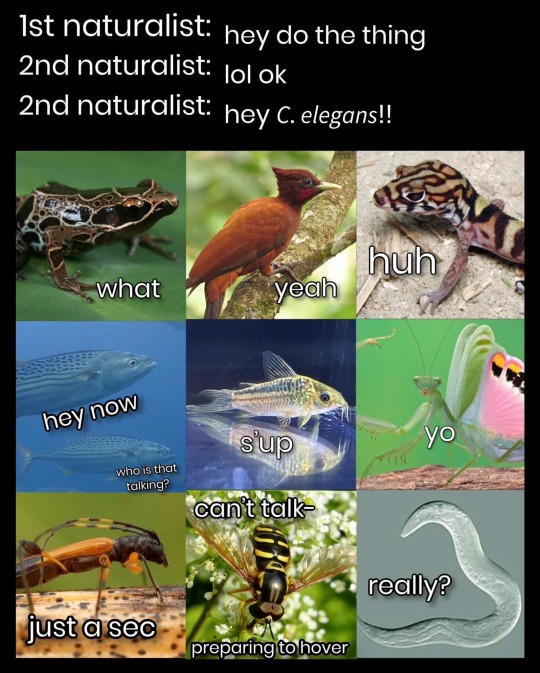
7K notes
·
View notes
Text
My soil texture triangle post has become popular beyond my wildest dreams so sorry not sorry to report that soil texture triangle is old news in this new year its all about

✨️Anura Limb Length and their Adaptions✨️
#soil texture triangle#anura limb length and their adaptations#anura#frogs#toads#graphs#animal science#herpetology#wildlife science#fisheries and wildlife science#woman in stem#science#biology#zoology
736 notes
·
View notes
Text
I'm struck again with the wild (exciting) and overwhelming thought of I don't know what I want to do with my degree once I get it.
I wanted to be a wildlife technician and go out into the woods and collect data on different species to bring back for analysis. That's the DREAM. But this, unfortunately, would require me to travel and be out of the home for 5-6 weeks at a time. That is off the table for me since I have pets. Unless jobs for that come up in the national forest I live near, no can do.
So I'm sitting here running through the types of things about this science that fascinate me and trying to plot out jobs from there. Of course things can change in four years and I'm sure something will stand out to me through my schooling that will point me there.
But I want to know what I should focus on NOW uuugh
#wildlife#wildlife science#wildlife conservation#student#college#university#studyblr#dark academia#trophic cascades
2 notes
·
View notes
Text
[ Edit: This new series will begin February 1st, 2024! ]
Heya everyone!
I need some help deciding which direction to take our Herptile of the Week segment in!
Option A.) Herptile of the Week becomes Herptile of the Day! This option would include one post per day regarding a particular herptile with each day being focused on a new herp! The post would entail similar content as to what has already posted in the past for the segment, including valuable details about the species and any interesting facts or studies regarding them that I come across during my research and much more! I would also like to include a little drawing of our chosen herp, done by me, with each post! :D
Option B.) Herptile of the Week would stay relatively the same as to how it already was, except posts will be less frequent, with one post every other day rather than everyday. We would still focus on one herp every week, with each post focusing on a different topic, but there would be less content overall. A drawing at the end of the week of the chosen herp will possibly also be included, but that would depend on timing and other stuffs :)
Option C.) Suggest a different solution! If you have any other ideas on how to format Herptile of the Week/Day(?) please feel free to send it to my ask box!
#Herptile of the Week#herpetology#herptiblr#herpetofauna#herptiles#reptiblr#reptiles#amphibians#amphiblr#animals#animal education#wildlife#wildlife education#wildlife science#educational#zoology#science
2 notes
·
View notes
Text
Love feeling the AuDHD flowing through my veins the moment my physics professor brought up the physics of bird flight. No Adderal can mimic THAT kind of focus!
0 notes
Text
A study that just came out demonstrates that outdoor cats are known to prey on over two thousands species of wild animal, from mammals to birds to insects. That includes 347 species that are endangered, threatened or otherwise of concern, and they've been a key factor of the permanent extinction of over 60 species. And while cats may not always bring home what they catch, chances are if your cat is allowed to roam unsupervised outside, they're killing your local wildlife.
Why is this so important? Worldwide, wild animal populations have decreased in number by 69% in the past fifty years; that means that in my lifetime (born in 1978), the sheer number of wild animals in the world has been decreased by over half. Even "common" wild species are less numerous than before. While habitat population is the single biggest cause of species endangerment and extinction overall, outdoor and indoor/outdoor cats are a significant cause as well. In fact, they are the single biggest cause of human-caused mortality in wild birds.
Most importantly, it's very, very simple to fix this problem: keep your cats indoors, and spay and neuter them. If your cat is bored, they need more enrichment, and there are plenty of ways to make your home more exciting for them, from bringing home cardboard boxes for them to explore, to playing with them more often. If you want your cat to get some outdoor enrichment, leash train them (yes, it can be done!) If you have the space and resources, build them a catio where they can be safe from outdoor dangers like predators and cars, while also keeping local wildlife safe from them.
If you just give into their whining and pawing at the door, then they know that that's what they have to do to get their way; I know it's a tough transition, but it's worth it in the end for everyone involved. Cats are domesticated, which means they are not native anywhere in the world; there are exactly zero ecosystems in which they belong, save for the safety of your home. It is your responsibility to give them an enriching environment without taking the shortcut of letting them go wreak havoc outside.
#cats#outdoor cats#feral cats#nature#wildlife#animals#ecology#environment#conservation#science#scicomm#birds#endangered species#extinction#domesticated animals#domestication#biology#animal behavior#animal welfare
8K notes
·
View notes
Text
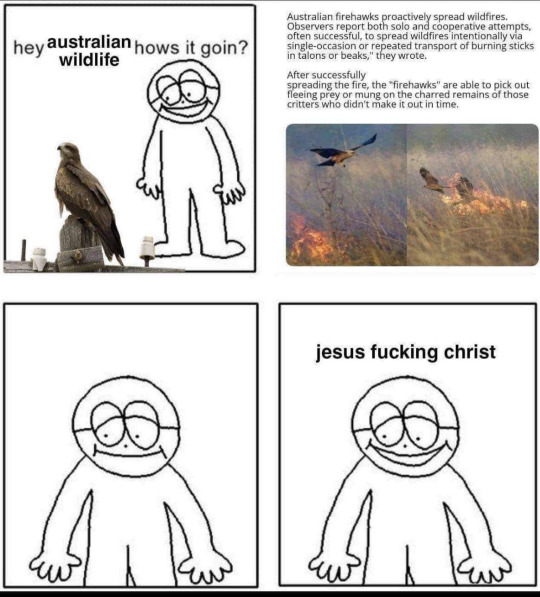
#green memes for ecological fiends#zoology#ecology#bird#hawks#environmental science#biodiversity#conservation biology#conservation#wildlife
28K notes
·
View notes
Text
EEEEEEEE EEEEEEEEE EEEEEEE
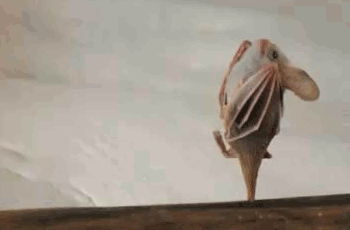
That's right! It's International Bat Appreciation Day! We share our planet with over 1400 species of bat, making the second most abundant mammal order, and they perform a wide variety of ecological roles, from dispersing seeds to pollinating flowers to eating thousands of insects in a single night! Over 200 bat species are listed as Threatened by the International Union for the Conservation of Nature--that is over 14 percent of all bats!
YOU can help endangered bats today by donating to Pennsylvania Bat Rescue at this link. This PA-based organization rehabilitates sick or injured bats and helps educate people like you and me in how we can create more bat-friendly environments.
If you want to learn about particularly-cool bat species native to New Zealand, check out this Consider Nature article on the Pekapeka, the bat that walks:
For the rest of the day, Consider Nature will be bat-bombing Tumblr with some of our favorite bat species to share them with the world!
Alt text: a small brown bat stretching its wings with the kind of fabulous flourish that would impress Ryan Evans.
#animals#nature#science#biology#wildlife#conservation#environment#bats#international bat appreciation day#batbombing
4K notes
·
View notes
Text

It’s Wednesday, so hang in there like the bank vole (Myodes glareolus)! Though it resembles a mouse, this species is distinguished by a shorter tail and stockier build. Mostly herbivorous, it’s a proficient climber that uses acrobatic skill to reach seeds and fruits. Its diet also includes moss, fungi, and nuts. Weighing up to 1.27 oz (36 g), this diminutive critter can be found across most of Europe as well as parts of Asia.
Photo: Sue Cro, CC BY-NC 2.0, flickr
#science#nature#natural history#animals#mouse#vole#bank vole#cute animals#wednesday#did you know#fact of the day#fun animal#animal kingdom#wildlife
1K notes
·
View notes
Text

This is a metal snail (Volcano Snail) that lives on underwater volcano vents in the Indian Ocean. Its shell and scaly feet both are armoured with layers of iron, making it the only animal to incorporate iron sulfide into its skeleton 🐌
📷: Dr Chong Chen/IUCN
#snails#snail life#snail#iron snail#oceans#indian ocean#science#news#research#biodiversity#iucn#iucn red list#science acumen#wildlife biologist#marine biology#biology#volcano#active volcano#amazing
4K notes
·
View notes
Text

Wolves Keep Brain Worm–Spreading Deer Away From Moose Populations in Minnesota
Wildlife managers now face the challenge of creating conservation plans for all three species while maintaining balance between predator and prey animals
In Minnesota, moose used to roam the boreal forests by the thousands. The population had 8,800 individuals in 2006, and since then, numbers in the northeastern part of the state alone have fallen by 64 percent, reports Liz Scheltens for Vox.
Warmer, shorter winters, tick infestations, liver issues, wolves, and parasites all contribute to declines in remnant Minnesota moose populations, reports Dennis Anderson for the Star Tribune.
However, the biggest threat may be migrating white-tailed deer. As deer entered moose habitats, they brought brainworm, a fatal parasite to moose. While harmless to white-tailed deer, the parasite (Parelaphostrongylus tenuis) causes disorientation, extreme weakness, and the inability to stand in moose.
It may be a critical factor as to why Minnesota's northern moose populations have declined significantly...
Read more:
https://www.smithsonianmag.com/smart-news/plummeting-minnesota-moose-populations-may-recover-with-help-from-wolves-180979484
#moose#ecology#climate#climate science#parasites#ungulate#mammal#animals#nature#north america#wildlife science#science
245 notes
·
View notes
Note
can you do one about vampire squids ? 🦑

Vampyroteuthis infernalis or Vampire Squid
It's (very dramatic) scientific name means "vampire squid from hell". However, the vampire squid is not actually a squid! It's actually the only animal in the Vampyroteuthidae family! It's separated into its own family because it can't change color or produce ink. Instead, it turns itself "inside out" (as shown above) to deter predators.
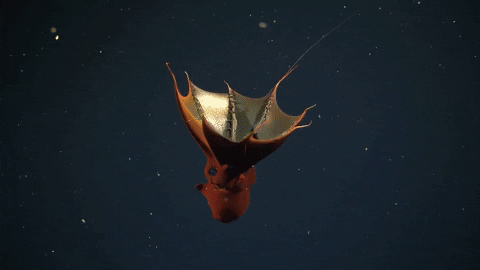
Proportionally, vampire squids also have the largest eyes compared to their body size! They eat mostly zooplankton, marine snow, and other organisms waste. They grow to be about the size of a football and live to be around 8 years old.

There's even evidence that vampire squids have been around since the Jurassic period- almost 200 million years ago!
#marine biology#marine ecology#animals#science#biology#animal facts#wildlife#marine life#ocean#fun facts#vampire squid#cephalopods#sea creature#squid#sea animals#sea creatures#sea animal#cool animals#zoology#ichthyology#sea#seas#oceans#the ocean#deep sea#jurassic period#fun animal facts#weird animal facts
1K notes
·
View notes
Text
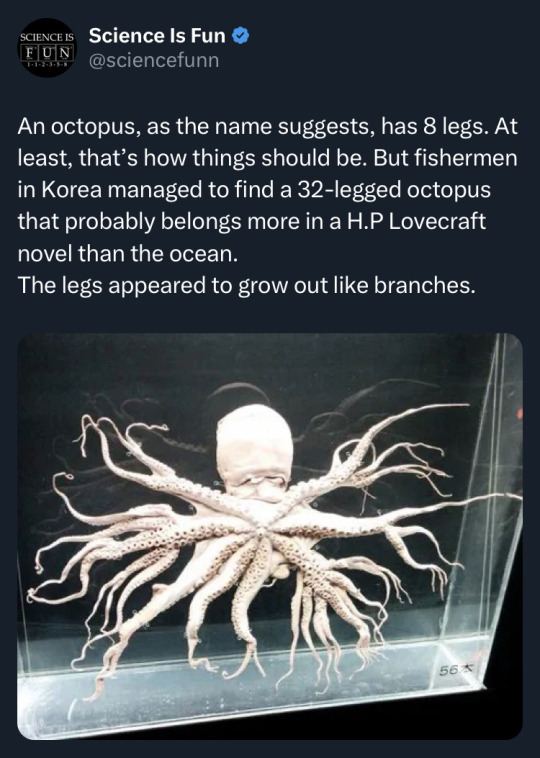

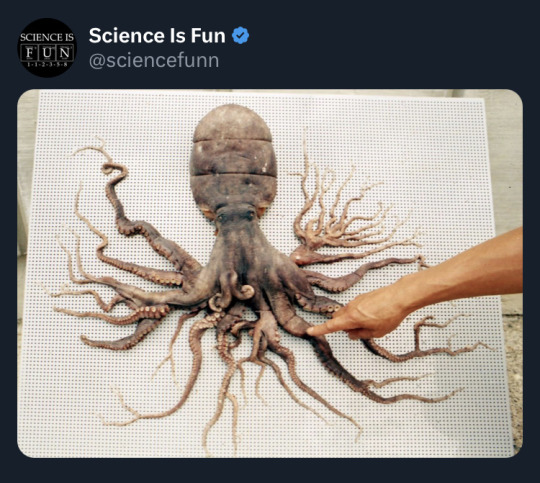
If you enjoyed this post, please give it a ❤️ and check out @scienceisdope for more science and daily facts.
2K notes
·
View notes
Text

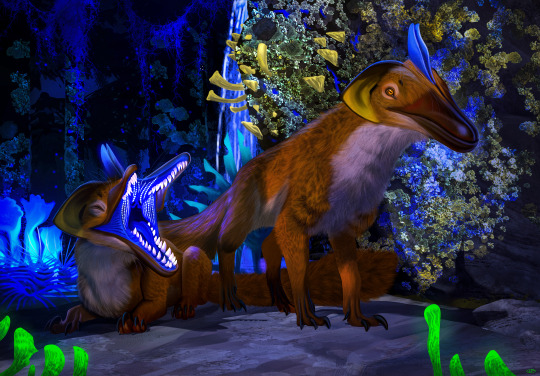




Here is another collection of exotic alien wildlife.
#my art#illustration#alien creature#alien#scifi art#science fiction#speculative zoology#speculative biology#speculative evolution#xenobiology#bioluminecent#bioluminescence#space#scifi illustration#wildlife art#wildlife#creature design
927 notes
·
View notes
Text
Proteles cristata
Throughout history, there have been two types of hyenas: bone-crushing hyenas, and dog-like ones. Spotted, striped, and brown hyenas are the bone-crushing type. Of the dog-like hyenas, the aardwolf is the only species left.

Aardwolf means "Earthwolf" in Afrikaans, a language spoken in Southern Africa. Their use of burrows is what earned them the "earth" part of their name. Although wolf is also in its name and it looks very dog-like, aardwolves are not canines. They are the smallest of four hyena species, weighing around 20 pounds (9.07 kg).
Unlike the other hyena species that eat carrion, aardwolves eat insects. If they really need to they can also eat eggs, small mammals, and vegetation, but insects are preferred. Their main insect prey is termites, and they can eat up to 300,000 of them in one night using their long tongues. Their tongues are very sticky as well, with large papillae (those little tongue bumps) and sticky saliva.
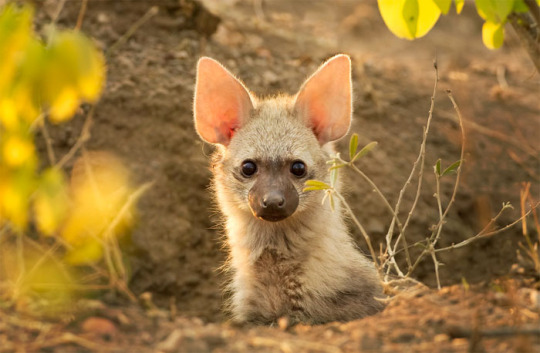
Since they behave differently and are much smaller than other hyena species, scientists used to think aardwolves were not part of the hyena family. With their striped coats, researchers thought they might have even been mimicking the striped hyena.
Aardwolves are found in arid plains of eastern and southern Africa, where they live in burrows dug by aardvarks, springhares, or porcupines. Some dig their own burrows, but taking over an abandoned one is much easier. They sleep in these burrows during the day, coming out at night to hunt for insects and to hang out with friends or whatever.
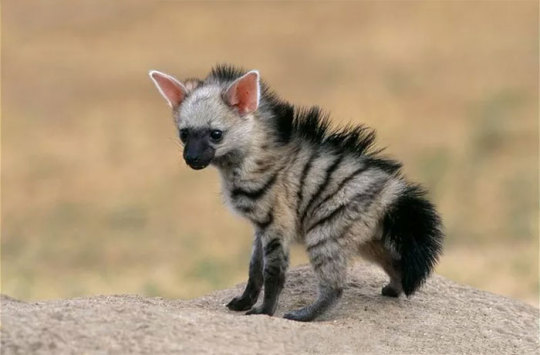

I rate the Aardwolf 15/10. Little cuties :,)

Photo Credits:
(1) Catherine Withers-Clarke (2) Hennie van Heerden (3) H. van den Berg (4) Scott Roberts (5) Klaus Rudloff
#aardwolf#CUTEEEEEEE#little guys#earthwolf#hyena#aardwolves#hyaena#biology#zoology#animals#science#nature#wildlife#african animals#cute animals#animals u should know about#miniature hyena
1K notes
·
View notes
Text
Okay, I know people as a general rule tend to not care about invertebrates as much as cute, fuzzy mammals, but this is a must-read if you care about animal welfare. The short version is that horseshoe crab blood has been used for decades in medicine as a way to test whether something is truly sterile; the blood clots in the presence of bacteria. Since then millions of horseshoe crabs have been captured and drained of blood, even though a synthetic alternative was developed a few years ago.
They go through a pretty brutal experience in the process. They're caught by fishermen who often throw them by their tails into a pile in the open air, and they're then trucked to a bleeding facility where they're strapped down and their blood is removed with needles jabbed directly into their hearts. Over half their blood may be taken, after which they're supposed to be returned to the ocean. However, it's likely many of them never make it back, instead turned into fish bait and sold by the same fishermen who caught them in the first place.
Apart from the fact that this is a horrific thing to put any animal through, the attrition due to fatalities has put a serious dent in horseshoe crab numbers. This is compounded by massive habitat loss, pollution, and the capture of horseshoe crabs as food, particularly as the females of one species are considered a delicacy. And other animals that rely on horseshoe crabs are suffering, too. The American rufa subspecies of the red knot, a medium-sized shorebird, is critically endangered as the horseshoe crab eggs it must have in order to successfully complete migration have become increasingly scarce, and it is likely the bird will become extinct if trends continue.
While there are guidelines for medical horseshoe crab harvest, they're considered optional. The few laws that exist are poorly enforced. Short of a complete ban on horseshoe crab blood in favor of the synthetic alternative, these animals are in very real danger of going extinct after a history spanning over 400 million years on this planet.
Thankfully, this article is not the first to bring forth the issues surrounding horseshoe crab harvest. Here are a few resources for further information and action (US based, though horseshoe crabs are threatened throughout their entire range):
Horseshoe Crab Conservation Network - https://horseshoecrab.org/conservation/
Wetlands Institute - https://wetlandsinstitute.org/conservation/horseshoe-crab-conservation/
Horseshoe Crab Recovery Coalition - https://hscrabrecovery.org/
#animal welfare#animal cruelty#cw animal cruelty#animal suffering#horseshoe crabs#invertebrates#wildlife#animals#environment#conservation#endangered species#extinction#nature#medicine#science#scicomm#science communication
8K notes
·
View notes